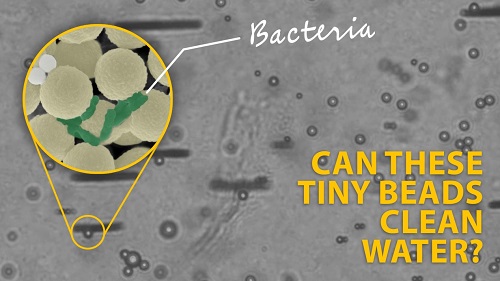
Researchers designed a swarm of tiny spherical robots to collect bacteria and small pieces of plastic. Image credit: American Chemical Society
When old food packaging, discarded children's toys and other mismanaged plastic waste break down into microplastics, they become more difficult to remove. In a study published in the latest issue of ACS Nano, a journal of the American Chemical Society, Czech researchers describe a swarm of microscopic robots that can capture plastic fragments and bacteria from water. The robots can then be purified and reused.
Microplastics are 5 mm or smaller in size, and animals can easily ingest them and be harmed. These animals then pass the particles into the human food chain. At the same time, microplastic fragments can also attract various bacteria, including pathogens, posing a greater threat to organisms.
In order to remove microorganisms and microplastics from water at the same time, the Brno University of Technology in the Czech Republic has developed a micro-robotic system composed of many small parts working in collaboration to mimic biological groups in nature, such as schools of fish.
The team attached positively charged polymers to magnetic microparticles that move only when exposed to a magnetic field. Polymer threads extending from the surface of the beads attract microplastics and microorganisms. The finished individual robots are 2.8 micrometers in diameter. When exposed to a rotating magnetic field, the robots cluster together. By adjusting the robots, which self-organize into flat clusters, the movement and speed of the robot group can be changed.
The team used Pseudomonas aeruginosa, which can cause pneumonia and other infections, to replicate microplastics and bacteria in the environment. The results showed that the microrobots successfully captured about 80% of the bacteria, and free plastic beads were also captured by the microrobots. The researchers then collected the robots and separated the bacteria using ultrasound, and then exposed them to ultraviolet light for disinfection, allowing them to be reused.
Previous article:ABB expands modular industrial robot product line to create highly flexible and customized production
Next article:Robot maker Kevin McAleer launches Raspberry Pi fortune-telling machine
- Popular Resources
- Popular amplifiers
- Using IMU to enhance robot positioning: a fundamental technology for accurate navigation
- Researchers develop self-learning robot that can clean washbasins like humans
- Universal Robots launches UR AI Accelerator to inject new AI power into collaborative robots
- The first batch of national standards for embodied intelligence of humanoid robots were released: divided into 4 levels according to limb movement, upper limb operation, etc.
- New chapter in payload: Universal Robots’ new generation UR20 and UR30 have upgraded performance
- Humanoid robots drive the demand for frameless torque motors, and manufacturers are actively deploying
- MiR Launches New Fleet Management Software MiR Fleet Enterprise, Setting New Standards in Scalability and Cybersecurity for Autonomous Mobile Robots
- Nidec Drive Technology produces harmonic reducers for the first time in China, growing together with the Chinese robotics industry
- DC motor driver chip, low voltage, high current, single full-bridge driver - Ruimeng MS31211
- Innolux's intelligent steer-by-wire solution makes cars smarter and safer
- 8051 MCU - Parity Check
- How to efficiently balance the sensitivity of tactile sensing interfaces
- What should I do if the servo motor shakes? What causes the servo motor to shake quickly?
- 【Brushless Motor】Analysis of three-phase BLDC motor and sharing of two popular development boards
- Midea Industrial Technology's subsidiaries Clou Electronics and Hekang New Energy jointly appeared at the Munich Battery Energy Storage Exhibition and Solar Energy Exhibition
- Guoxin Sichen | Application of ferroelectric memory PB85RS2MC in power battery management, with a capacity of 2M
- Analysis of common faults of frequency converter
- In a head-on competition with Qualcomm, what kind of cockpit products has Intel come up with?
- Dalian Rongke's all-vanadium liquid flow battery energy storage equipment industrialization project has entered the sprint stage before production
- Allegro MicroSystems Introduces Advanced Magnetic and Inductive Position Sensing Solutions at Electronica 2024
- Car key in the left hand, liveness detection radar in the right hand, UWB is imperative for cars!
- After a decade of rapid development, domestic CIS has entered the market
- Aegis Dagger Battery + Thor EM-i Super Hybrid, Geely New Energy has thrown out two "king bombs"
- A brief discussion on functional safety - fault, error, and failure
- In the smart car 2.0 cycle, these core industry chains are facing major opportunities!
- The United States and Japan are developing new batteries. CATL faces challenges? How should China's new energy battery industry respond?
- Murata launches high-precision 6-axis inertial sensor for automobiles
- Ford patents pre-charge alarm to help save costs and respond to emergencies
- New real-time microcontroller system from Texas Instruments enables smarter processing in automotive and industrial applications
- Delay problem in single chip microcomputer
- Top 10 technology predictions for 2021
- Pre-registration for the live broadcast with prizes | New opportunities in the UWB market
- Can the highest main frequency of DSP be obtained from the chip model?
- Electronic engineers, did you take advantage of yesterday's price war?
- The ultimate PCB material for entry-level nanny
- 5 major drawbacks of using UWB for indoor positioning, a full summary of practical information
- Benefits of IoT
- Application suggestions for 2.1GHz and 3.5GHz frequency bands in 5G networks
- 【NUCLEO-WL55JC2 Review】Summary

 RH1014MW#PBF
RH1014MW#PBF
















 京公网安备 11010802033920号
京公网安备 11010802033920号